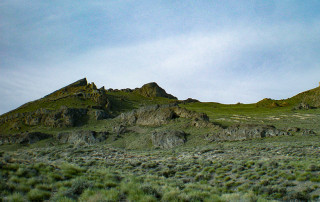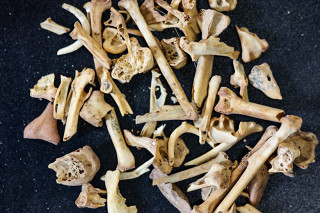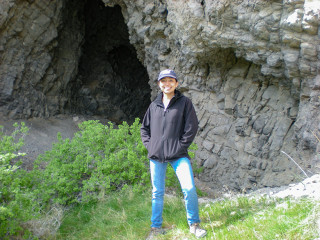The Cave That Holds a Million Bones
By Michael Mozdy
Imagine you’re in a cave about the size of a long garage on the side of a lake. It’s cool, dry, and so remote that no humans have made it their home. Owls are the only inhabitants, and they spit up the undigested bones, fur, teeth and insect shells in the form of “owl pellets” on the cave floor. Week after week, year after year, century after century – indeed, millennium after millennium owls do this mundane task, a part of their biology, in a remote cave no one knows exists. In so doing, they leave an unspoiled record of the creatures they ate: a compact time capsule of an ecosystem.
In the mid 1990s, paleontologist Dave Madsen and zooarchaeologist Don Grayson found and excavated a cubic meter of bones from just such a cave – now called Homestead Cave – west of the Great Salt Lake. Somehow, prehistoric humans never made it their permanent home, and its location within the Utah Test and Training Range has kept modern humans out.
This one cubic meter of bones represents 18 distinct strata dating back 13,000 years, and hundreds of thousands of carefully packed tiny bones have made their way to the permanent collections at the Natural History Museum of Utah.

What Boneyards Tell Us About Climate Change
Before finding their way to NHMU, Grayson spent five years in a lab, sorting hundreds of thousands of tiny bones and classifying the age of the layers. Owls eat everything from rodents to fish, lizards, and other birds, and Grayson’s team sorted the bones into these categories. Next, researchers took a first crack at identifying the small mammals and the fish.
Both sets of bones have yielded significant and somewhat surprising insights into how these communities changed as climate changed. Homestead Cave was initially under the waterline of the huge Lake Bonneville. But around 13,000 years ago, as Lake Bonneville was declining, Homestead Cave was revealed, and the layers of bones can tell us what happened to the diversity and relative abundance of the owls’ prey as the lake continued to decline.
Jack Broughton, a faculty member in the University of Utah’s Anthropology Department, dove into the trove of fish bones. Of the 14,866 fish bone specimens representing 11 freshwater species, he found that most of them came from the first stratum from the cave. Broughton explains that dramatic increases in fish remains mark periods when the lake level fell, causing increases in water temperature and salinity and ultimately the fish populations to die-off. "There are two such apparent die-off events, one at 13,000 and one near 10,400 BP," (Before Present) he claims.This helps paleoclimatologists get a much more precise look at climate in the Great Basin. Broughton writes that “since there is perhaps a no more sensitive measure of regional climate than the size of closed-basin lakes, paleofish faunas can potentially provide one of the more direct proxies of climate change.” According to Broughton, things heated up significantly around 10,400 years ago, as shown by a massive fish die-off.
Rebecca Terry and Rebecca Rowe, collaborators with NHMU’s Vertebrate Zoology Department, examined the Homestead Cave rodents and learned something different. Rodent diversity and abundance took a nose dive not 10,000-some years ago, but in the 1800s. Terry and Rowe attribute this decline to the change in food source, specifically the rampant proliferation of non-native switch grass that was introduced by modern human migration. Rodents adapted to the conditions that spelled the demise of fish in the lake, but were greatly affected by an unforeseen consequence of human settlement.
Bird Bone Bonanza
With small terrestrial mammals and fish now counted, classified, and analyzed, there remain several other treasures from that square meter of Homestead Cave yet to examine: reptiles and amphibians, pollen samples, and birds. A graduate student in zooarchaeology and awardee of NHMU’s 2016 Summer Internship by the name of Allison Wolfe is hard at work tackling the tens of thousands of avian bones found at the site.

Wolfe has been sifting through many plastic bags filled with bones in just the first two strata (the oldest ones), and learning much along the way. “We know there were some big owls, like Great Horned Owls, because we’re seeing some big bones, like duck,” she explains.
In the bottom 10 cm (stratum 1) of the excavation, Wolfe has catalogued almost 4,000 different bird bones, representing potentially 50 different species. The original sifting through the bones and rough cataloguing was hampered by the lack of comparative skeletons to help identify them. Thus, some could only be identified to the genus or even family level. Thanks to the resources at NHMU and the Anthropology Department at the U, Wolfe is able to be much more specific with her identifications. While the work is mind-numbingly voluminous, it does have its moments of excitement: at times she has had to develop her own criteria to differentiate between species in a way that has not yet been formally described in scientific literature.
Broughton is enthusiastic about Wolfe's work. "Distinguishing different species of closely related birds from fragmented bones is extremely difficult and developing this skill can take many years of detailed study. I was truly shocked how fast Allison picked this up—she has a rare gift," he says.

Wolfe is just finishing stratum 2, with 16 more to go. In the oldest two levels she’s seeing a lot of ducks, grebes, shore birds, and small passerines (perching birds). Already in this span of time (a few thousand years) she sees less big, fish-eating grebes and diving ducks and more small grebes and dabbling ducks. “We’re confirming ecosystem and habitat theories of fauna with hard evidence,” she explains.
Wolfe is excited to see what larger narrative might emerge. For instance, she has identified a lot of greater sage grouse bones, and there has been some discussion of putting that bird on the endangered species list today, so she wonders if this contiguous record of the bird might reveal when its abundance changed.
What’s more, now that we know humans are affecting climate, we can look at how birds responded to climate change in the past and forecast from there. It’s another example of how the work of museums is one that is so relevant and necessary to modern understanding of our changing world.
See for Yourself
An exhibit on NHMU’s third floor gives you a chance to read more about Homestead Cave and even imagine what this bone-combing work entails. Between the Basin and Range geology ramp and the Past
Worlds dinosaur gallery is a table dedicated to Homestead Cave, complete with owl pellets and a clear tube of the tiny bones researchers found on the site. It’s well worth a visit.

Two families of creatures – terrestrial and aquatic – have changed in different ways and at different times within our interconnected ecosystems in Northwestern Utah. Will examination of airborne animals tell yet one more tale?
With Wolfe’s work, we are certain a new one will unfold.
Michael Mozdy is a Digital Science Writer for the Natural History Museum of Utah, a part of the University of Utah in Salt Lake City. Our mission is to illuminate the natural world and the place of humans within it. In addition to housing outstanding exhibits for the public, NHMU is a research museum. Learn more.

